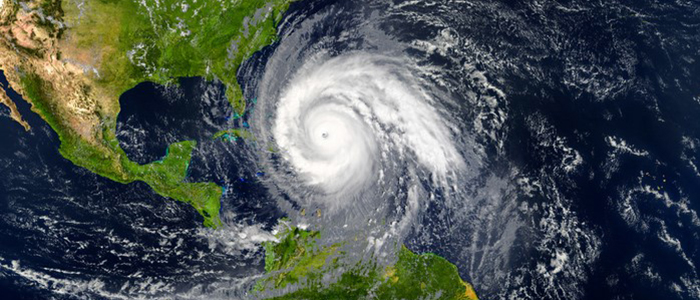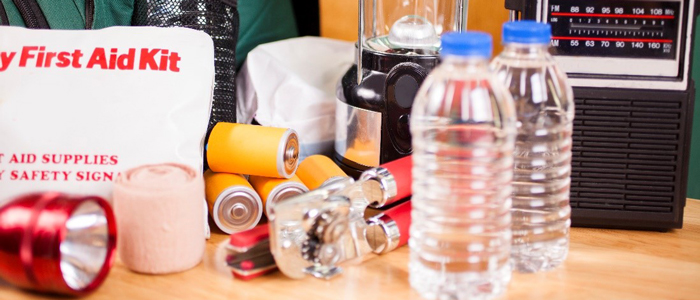Cash, chargers, flashlights – check out this storm-ready checklist

Below are great tips and good practices restaurateurs can use to prepare for a weather event before, during and after it hits their areas. Let’s start with the following 12 tips to help you prepare for weather events such as hurricanes or tornados:
How to prepare for a weather event or natural disaster
- Meet with your health department in advance to write pre-approved emergency operating plans for water and power disruption. Establishments that do this can typically either stay in operation or re-open quickly, without re-opening inspections, and are better positioned to help the community and business return to normal quickly.
- Establish an emergency team to step in as leaders during the disaster. Members of the team should reflect all facets of the business: e.g., operations, food safety, technology, marketing/communications, and engineering and construction.
- Compile an emergency contact list in advance for all employees and key management at corporate. Maintain it on cell phones and in written form off site. Include vendors, trash pick-up services, pest management, and other support systems you will need to keep your establishment running. Establish a staff phone tree.
- Keep up with news and weather reports. If your area is under a storm watch, that typically means you have some time before it hits your area. If you are under a storm warning, that generally means the weather event is imminent and that you should begin following procedures for shutting down your operation, begin your warning and evacuation procedures, and make plans to assist employees who need transportation.
- Board up your windows. One good option is to cover them with 5/8-inch marine plywood. Also, if you are located in a low-lying area or prone to flooding, place sandbags by the doors and other entrances.
- Secure heavy objects. Take pans down from their hangers, remove smallwares from shelves, unplug items and tape your drawers and cabinets shut. Also, secure or move outdoor furniture and equipment if it’s safe to do.
- Turn thermostats down low in your walk-ins and seal the doors shut. Doing this might help save your food if the power goes out (and no water gets in). Also, be sure to turn off your equipment and utilities, including electric, gas and water.
- Make sure you have access to communication devices, flashlights, batteries and emergency supply-kit contents such as first-aid items, cell phones with chargers (for outlet, power bank, and car), as well as a whistle to signal for help. Charge your cellphones.
- Have a supply of cash on hand. A storm could knock out ATMs, POS systems and payment-card terminals. If you get partially operational again, you might need to do transactions in cash. Also, employees might need pay.

- Protect your vital business, employee and financial records. Make a ready-to-grab storm-file with copies of documents that are critical to your business. Include a sales history, floorplan of the restaurant, insurance documents, payroll and a copy of the key contact list. Unless you store information in the cloud, it will save you a lot of recovery time if your data and information technology systems remain intact. If it’s safe, pack up and load your portable office equipment, such as computers and back-up drives.
- Call your vendors and cleanup crews and get your name on the list in advance for a refrigerated truck and cleanup services.
- Consider purchasing or arranging for the following backup systems:
- Portable, gas-powered pumps that will remove flood water
- An alternate power source, such as a generator
- Battery-powered emergency lighting.
During the storm: Shelter in place?
If flooding is not a threat, it’s sometimes safer to take shelter where you are. If you shelter-in-place:
- Designate a shelter area in your restaurant. If you don’t have underground shelter, go into an interior room or hallway on the lowest floor possible, preferably without windows. Bathrooms, closets, offices, maintenance rooms — all could work if a basement’s not available.
- In a high-rise building, go to a small interior room or hallway on the lowest floor possible.
- Stay away from windows (which should always remain closed), outside doors and outside walls.
- Account for all employees and customers as people arrive in the shelter. In general, you can’t force your employees to shelter, but there are circumstances when local officials will order everyone to stay put. It’s imperative you talk with your staff members about sheltering before an emergency to avoid confusion and possible conflict.
- Assign specific duties to employees in advance but designate and train alternates in case the assigned person is not there or is injured. For example…
- Who informs guests and employees where to go?
- Who shuts down equipment and utilities?
- Who secures outdoor furniture?
- Who tapes or boards windows?
- Who removes heavy objects from up high?
- Get disaster supply kits ready and keep them in your shelter areas.
- Stay in the shelter location until the danger has passed.
What to do after the hurricane or tornado hits
Quick recovery demands a plan. Here are 14 tips to think about:
- First, check yourself and others for injuries. Provide first aid to anyone who needs it, and try to contact emergency help by calling 911. Do NOT use the phone unless it is an emergency.
- Listen to news and weather reports to get the latest information.
- If you haven’t already done so, make sure you shut off your power at the control box. However, only do this if the conditions are safe.
- Gas from gas appliances could leak and get trapped inside the building so do not use any matches, lighters, or any other open flames. Instead, rely on flashlights.
- If you smell gas, leave immediately and leave the door open. Report it to the authorities.
- Make sure to check for and be aware of fire hazards, such as sparking equipment.
- Keep everyone away from standing water. Water on the floor and live electricity are a deadly combo that could result in electrocution, injury or death.
- Stay out of badly damaged buildings. If exiting a building after a storm, be careful around broken glass and debris on the ground and overhead. Make sure that anyone trying to help is wearing sturdy, closed-toe shoes or boots.
- Stay away from downed lines, even if the power appears to be off.
- Be careful opening cupboards, storage area doors, closets and such — items can fall out on you.
- Do not use water from faucets. Your area could be exposed to contaminated water after a storm.
- Call in your storm recovery contacts.
- Call/contact your insurance agent.
- Take photos and videos of damage so you can show it when filing an insurance claim.
The more prepared you are, the better you will be able to protect your people, business and assets.
This article is provided to you for general informational purposes only and does not constitute professional advice concerning the subject hereof. We strongly recommend that you consult with a professional regarding your specific circumstances prior to taking action. While we try to ensure the accuracy and completeness of the contents of our articles, we make no guarantees and are not liable for any loss or damage arising out of any use or reliance on the content of this article. We reserve the right to supplement, change or delete information in this article at any time.
Contributing resource: Ready.gov/hurricanes
